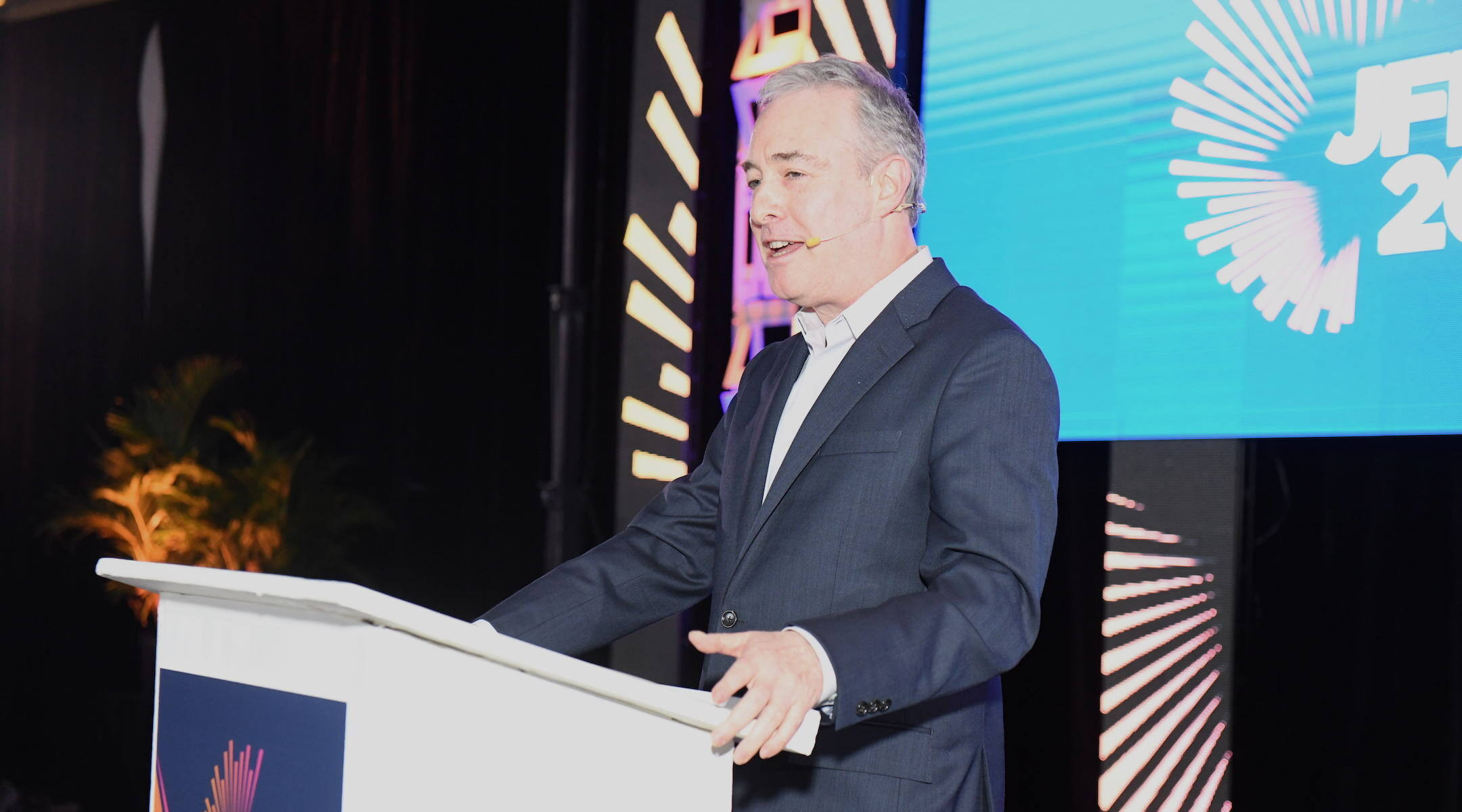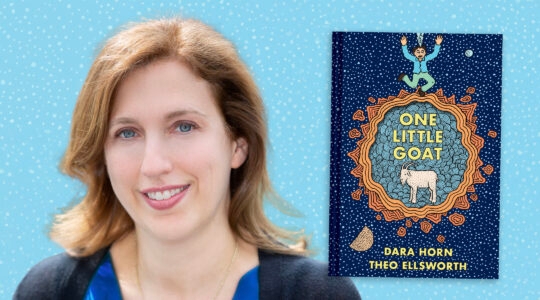(JTA) — In a good year, the annual conference of the Jewish Funders Network functions like a Jewish Aspen Institute: The Jewish fundraising elite, from private and family foundations that represent about $6 billion in annual philanthropy, gather to discuss the Next Big Ideas in Jewish life and who is going to pay for them.
And if this was hardly a good year, it was the first time in three years that the members were able to gather in person, from Sunday through Tuesday in Palm Beach, Florida. Some 540 people took part; according to JFN’s president and CEO Andrés Spokoiny, about 60% were funders themselves, and 40% professionals representing foundations and other Jewish philanthropies.
While the war in Ukraine dominated the hallway discussions, there were also sessions and talk about rising violence in Israel, threats to democracy, the impact of climate change, pandemic recovery and integrating the haredi Orthodox community into the broader world of Jewish philanthropy.
(JFN also announced a partnership with UJA-Federation of New York to provide up to $2.5 million in kosher-for-Passover Seder food to Jews in Ukraine and neighboring countries.)
In a keynote speech, Spokoiny laid out a series of challenges, which added up to a gloomy view of Jewish life: declining Jewish literacy, internal polarization and the stubborn persistence of antisemitism. But he also urged funders to dream big, and to “risk more than others think safe.”
I spoke with Spokoiny after the conference about how funders are responding to the Ukraine war, the long-term impact of the pandemic and how organizations need to retool if they are to do more than survive.
(Spokoiny and other speakers at the conference were aggressive in condemning Vladimir Putin and the humanitarian crisis he has caused. I asked Spokoiny about the Russian-Jewish philanthropists who are now facing sanctions for their real and perceived closeness to the Kremlin, but he preferred not to comment. As JTA reported, three sanctioned Russian billionaires stepped down from the board of Genesis Philanthropy Group, a major funder of Jewish causes that partners with JFN on a research award, after they were sanctioned.)
Our conversation was edited for length and clarity.
JTA: This year, what was topping the list of people’s concerns?
Andrés Spokoiny: Ukraine was at the top for nearly everybody. What does it mean for the world, the Jews, democracy and philanthropy? And when we were there, there was a terrorist attack in Israel and then literally overnight, people started to be concerned again about that and we had a lot of conversations about where to go and how to leverage the Abraham Accords.
The pandemic was not per se the priority, but the impact of the pandemic. We think people are sort of emerging from the shell shock and are both relieved and afraid. Now, what are the long-term consequences?
You gave a speech in which you said, “The pandemic made more evident that there are deep cracks in our organizational models. We are stuck with 19th- and 20th-century models, models that worked well in times of low volatility and slow change but are woefully inadequate for times of uncertainty.”
I spoke about cracks in three key relationships: Our relationship with each other, of Jews with other Jews, and between Jews and Judaism. There are deep cracks that existed before but now were heightened by the pandemic. For example, the membership model has been teetering for the last probably 10, 15 years. What does it mean to be a member today? Are you going to be a member of a JCC to use its gym if you can buy a Peloton? Are you going to be a member of a synagogue when you can go online and look at sermons from your favorite rabbi? Every membership-based organization is challenged by a new ethos.
Another example is that we have by and large organizations that are based on the command and control model, when we need a collaborator and connect model.
Explain the distinction. What’s a command and control model?
It’s a classic 20th-century, European, industrial-era organization, where there’s always a man at the top and the information flows from bottom to top, and decisions flow from top to bottom. That’s not the way successful organizations work today. There’s tons of lateral leadership discussions and a free circulation of information.
Another thing is that [the future] is about platforms, and not about products. One of the things that we learned during the pandemic is high-quality content can be commoditized. Think of Airbnb, which is the difference between owning a hotel or owning your own Airbnb. Anybody can offer them. In that case, you’d rather be the platform for people to find them, like Uber: You want to be the platform instead of the taxi owner. In a way, our community was about owning the hotel rooms. But the pandemic exposed us in a very painful way, and in a very positive way too, that you can’t get away with poor quality.
So they need to encourage innovation and high quality programming at the grassroots level and be the platform to connect people with it. Is there someone who’s gotten the idea of the platform?
There is innovation, there are people doing a lot of good things, but I think that the general mood in the community is one of exhaustion from the fight to survive. Now, it was a successful fight. They didn’t collapse. But now that we can lower our arms the real challenge starts. We had a “moonshot” session, for example. Not because moonshots are the solution, but because we wanted to challenge people to think big and in the end to say that survival during the pandemic was not an end in and of itself. It was only the beginning. That was kind of the vibe of the conference.
What are some of the examples of the moonshots people proposed?
Not to be self-serving, but I put forward mine, which was universal Jewish literacy for adults. But there were others. There was one about transforming the rabbinate. There was one about creating a healthy and robust philanthropic infrastructure. There was another one about bringing God back into the conversation. We had a conversation about feminism, and another about how to completely redefine the way we fight antisemitism in social media.
You also spoke about that in your speech, saying, “We have little idea of how the dynamics of influence on social media work, and we keep throwing good money after bad.” What do Jewish organizations get wrong and what do they get right?
We think that publishing content on social media is like putting a full-page ad in the New York Times. But information now flows in different ways. Information gets consumed in different ways and people relate to content in different ways. There’s an amazing article by Gilad Lotan, the chief data scientist at BuzzFeed, about the 2004 war in Gaza. He mapped pro-Israel and pro-Palestinian traffic on social media, and when you see the map, they barely intersect. And that’s the problem: Literally millions of dollars going to people that already agree with us.
What’s the alternative?
Social media in many cases works with what I call a structure of permissions. For every person that will talk about something there will be 100 that agree but won’t say anything or won’t disseminate information unless somebody gives them permission. Let me give you an example: Ritchie Torres, a Democratic congressman from a heavily Dominican district in New York. It turns out that most Dominicans either don’t care about Israel or they’re positive about Israel. But they are not going to be “pro-Israel.” But if someone like Ritchie Torres says, “Hey, it is okay to be pro-Israel because I am like you and I am pro-Israel,” it empowers them to come out.
And as Lotan shows in his mapping, if you want to reach the other side, you need to work with people that you will not find 100% palatable. If you’re on the right, you don’t want to work with a media outlet like Haaretz because you hate them. But guess what, progressives read Haaretz. So if you can get a little bit of content in Haaretz, if you can manage to have them as an ally for something, it is worth 10 times a posting in a so-called right-wing outlet. But we have ideological rigidity that doesn’t let us do that properly. The question is, do you want to be right or do you want to be successful?
Or as you said in your speech, “The truth is that we live in different universes, and we are sharing way less than we need in order to maintain a cohesive people.” How can these big divisions be bridged?
I want to give you an example of what I mean. You know who the most effective single individual in fighting BDS was? Randi Weingarten.
The president of the American Federation of Teachers. When she was under pressure to support the Israel boycott, she said no but instead came out as critical of Israel in a way we used to call liberal Zionist.
Right. Randi Weingarten single-handedly stopped one of the most powerful unions in the country from adopting BDS. Many funders oppose her work: She’s big against charter schools and many funders are for charter schools. She’s a union defender and many funders are “right-to-work” kind of guys. They will have questions working with somebody like her. But the question is, what do you want? You want to fight BDS? It seems effective.
Another example is criminal justice reform. Amy Bach, a Bronfman Prize winner, spoke at our conference.
I was at the ceremony when she accepted the Charles Bronfman Prize. She’s the one who collects data at the courthouse level to measure criminal justice performance state by state.
Yes, and she managed to create coalitions in deep red states for criminal justice reform. If she would have stood on her ideological convictions, she wouldn’t have worked with the government of Louisiana or Mississippi and actually been successful.
I want to double back on Ukraine. We thought the era of Jewish rescue was over, and suddenly Jewish organizations are back in the rescue business. Rescue campaigns fill coffers and energize donors, but how do you keep that momentum going when there’s not a crisis?
The solidarity for Ukraine Jews may help us recover a sense of arevut, of Jewish responsibility. If there’s a silver lining to this crisis it is that it revitalizes the notion of how good it is to belong to a people, that we care for each other even if you’re 10,000 miles away. It’s not wrong to say you care for your people. It’s not going to be at the exclusion of others. So I hope it will help us recover a sense of mutuality.
But the problem, as the old saying goes, is that “any idiot can face a crisis; it’s this day-to-day living that wears you out.” Can we leverage what we learn beyond the crisis? Let’s talk about Ukrainian Jewish culture and what we are learning about how these people practice their Judaism. Russian- and Ukrainian-speaking Jews have, by and large, cultural Jewish identity which they managed to keep alive without a religious Jewish identity. So when we read in the Pew report that almost 30% of American Jews do not identify themselves as Jews by religion, we can look at Russian-speaking Jews and there are things for us to learn in their interaction with Jewish identity.
Applying some of your own critique to JFN itself: Is your organization itself embracing bold change of the kind that you’re talking about?
JFN is a network of peers. So I feel we were created as a platform for people to collaborate. But there is a conversation going on that started in the pandemic, and that is, what is the best value JNF can give to individual funders and to the philanthropic community as a whole? For example, one such bold step is that we are becoming much more global, and in the conference we showcased the global nature of the network by having people send in videos from their home communities. But to be frank, there’s perplexity too. I mean, we’re embracing that perplexity. In other words, we are still in the middle of it, and we don’t know where things are going to fall. And part of it is being open to learn as we go, and being open to take risks and accept failure when it happens. Moonshot thinking does not necessarily go from one to 100 in a second, right, it’s like a winding road. And sometimes it’s not about discovering a whole new idea, but it’s about discovering adjacencies.
Can you give me an example?
I mean repurposing something that already exists. Think about PJ Library, one of the big moonshots of the Jewish world, which delivers Jewish books and music to young families. It was both original and an adaptation of a program that Dolly Parton was doing. Or think of Birthright, whose success was possible because there were literally 20 years of trial and error, mostly error, in creating the youth Israel experience. It’s not as if an awesome genius has a lightbulb moment. It’s hard work and you have to be open to try and fail and try again, and then eventually things coalesce.
JTA has documented Jewish history in real-time for over a century. Keep our journalism strong by joining us in supporting independent, award-winning reporting.







